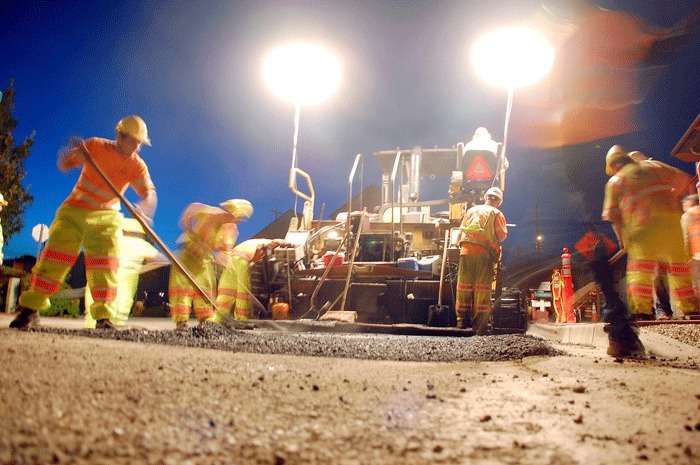For downtown merchants who have suffered months of dirt, dust and the drone of heavy machinery, nothing is as sweet as the smell of fresh blacktop in the morning.
And that’s exactly what they were greeted with when they arrived at work early Tuesday. Fresh and black as midnight asphalt, stretching from Dock to SE Ireland streets and from Ilwaco Alley to SE Midway Boulevard.
While it’s not perfect, as a final finishing layer has yet to come, it was a welcome sight nonetheless, said Ron Apgar, a shop owner and the president of the Downtown Merchants Association.
“It’s beautiful but a little rough,” he said.
Crews from Anacortes-based Lakeside Industries, a subcontractor for Oak Harbor’s primary project contractor, Strider Construction, spent Monday night and early Tuesday morning paving the roadway.
The $7.7-million city road project began in March, and was originally expected to wrap up in September. However, the discovery of Native American remains resulted in a project-wide shutdown that lasted longer than a month and pushed back completion. All but one block of the project should be done in October.
The delay affected businesses in different ways, as the project has been worked on in phases with construction moving in an easterly direction. Owners of shops located west of Dock Street were the first to feel the impacts of construction, but they were fortunate in that the shutdown occurred after the street in front of their stores was paved in June.
Merchants located in phase two of the project area, from Dock Street east, had the rotten luck of having the shutdown occur shortly after the street in front of their shops was torn up in May. To have fresh blacktop after so long is a welcome sight.
“No more dirt and no more dust,” said Rick Rennebohm, a Pioneer Way property owner.
He and his wife, Cheryl, came down Monday night to watch the paving. Supporters of the project from day one, the Rennebohms said the discovery of Native American remains and the subsequent delays were rough for everyone.
“People were really excited and then everything came to a screeching halt,” he said.
To finally have things moving again is a relief. He remains confident that once the project is finished, it will not only look beautiful but be successful as well. This is the shot in the arm downtown has needed and will no doubt turn the area into a destination, he said.
Others still aren’t so sure. Les Bense, owner of Oak Tree Antiques and a longtime critic of the one-way design, said he also was happy to see the new asphalt. However, his lack of faith in the project’s design remains.
“I’ve been in business all my life and never seen a one-way work,” Bense said.
Following Monday evening’s paving, all but about one-sixth of the construction project now has asphalt. The only portion of street that is still dirt is the block between Ireland and Ilwaco, the location of an enclosed archaeological dig site.
When the bones were first found in June, an expert from the state Department of Archaeology and Historic Preservation announced that the remains were from at least four people. Since then, additional human remains have been found in test pits. The same state expert said they came from at least three more people, making for a total of seven.
While the remains of the first four were collected so they could be reburied elsewhere, the new discoveries were left at the site. Their fate was to be decided in a meeting between the tribes, the city and the state office last week.
According to City Administrator Paul Schmidt, an agreement was struck to remove no more than 10 inches of soil. Anything found is to be removed and buried with the earlier collected remains. Once complete, the archaeologists will move to the north side of the street, formerly the westbound lane, and do the same thing there, he said.
Despite the ongoing archaeological efforts, the city is expecting most work on the road project to wrap up early next month and a celebration and ribbon cutting will be held Oct. 15. The event will include a five kilometer fun-run, a one-mile walk, free food and music.
One of the highlights is that the Swinomish Tribal Community has volunteered to cook 1,000 pounds of salmon, enough to feed about 500 people. It’s a heartwarming gesture and one that isn’t lost on merchants, Apgar said.
“That was actually a very nice thing to do,” he said.
So while criticism remains, for many the arrival of asphalt this week seems to have brought with it an optimism and hope for a bright future. Bob Olson, owner of Whidbey Wild Bird, said it will be a slow process but that people will begin returning to downtown.
“We’ve been struggling mightily since May but I think things are going to turn around,” he said.



